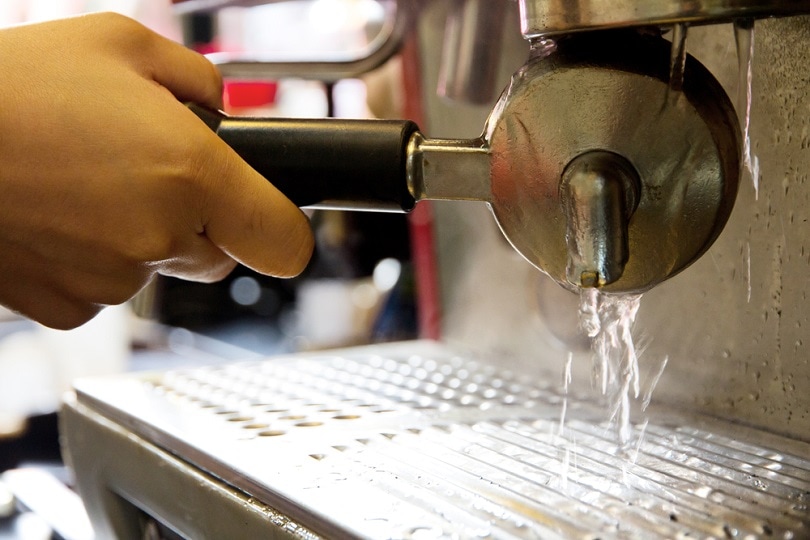
Many things go into making great espresso. You need excellent coffee, practiced technique, and a capable, clean espresso machine if you want to pull top-notch shots. A lot of time and attention is spent focused on the coffee and technique, but not many people give their espresso machine the care it needs to churn out great-tasting espresso year after year.
In this article, we discuss every home barista’s least favorite topic: cleaning the espresso machine. The good news is with regular maintenance, cleaning your machine does not have to be a painful, lengthy process. If you follow these simple steps regularly, your espresso machine will last longer and make better coffee consistently. Let’s learn how to clean an espresso machine.
The 4 Steps to Clean Espresso Machines
1. Gather Your Equipment
Before you start, you’ll need to make sure you have a few things on hand. It is helpful to have a soft rag and a brush to clean the filter screen and some cleaning tablets designed for cleaning espresso machines. These make it easy to clean the internal components without taking your machine apart.

It’s helpful to have a towel to lay wet parts on while you clean other pieces and a bucket if your espresso machine isn’t located near a sink. You will also need a screwdriver to get at the filter screen itself. What type of screwdriver you need will depend on what machine you have.
One last piece of gear you need is a blind filter for your machine. Many espresso machines come with one, but if yours didn’t, you’d have to pick one up if you want to backflush your machine.
2. Backflush Your Espresso Machine
Cafés do this every day, but their commercial machines also see far more use than the typical home espresso machine. If you feel ambitious and want to really stay on top of cleaning your espresso machine, you can perform a quick backflush every day you use it; however, backflushing every day is probably overkill. We recommend you find a happy medium and backflush at least once a week.
- Attach a blind filter and insert a cleaning tablet. Lock the portafilter to the machine the same way you would before pulling a shot.
- Run a brew cycle about 5-10 times. There are no specific rules to follow, so feel free to run more or fewer cycles if you think it’s warranted.
- Remove the portafilter and run another brew cycle, rinsing the portafilter as the water exits the machine.
- Reattach the portafilter and run 3-5 more brew cycles without a cleaning tablet. This step ensures there isn’t any residual cleaning tablet left in your machine.
- We recommend pulling a real shot with espresso and dumping it before you make any coffee to drink. This is a precaution to avoid accidentally consuming any cleaning material.
- Soak the metal section of the portafilter for 30 minutes in hot water.
The entire process of backflushing your machine should only take ten minutes of attention and another half an hour of waiting for the portafilter to soak. If you regularly backflush your machine once per week, you’ll extend the life of your machine and keep it operating smoothly.

3. Clean the Screen
The internal filter screen can become caked with coffee residue if you don’t give it special attention regularly. Luckily, the filter is accessible on most espresso machines and only requires removing a single screw.
Use your screwdriver to detach the screw holding the screen in place. Often this screw is located in the center of the screen and is easily unscrewed in a few short turns. Be careful not to strip this screw because your machine will be impossible to clean properly until you remove it, which can be a hassle.
Once you have the screen out, vigorously scrub it with the soft rag. It can take some serious elbow grease to get the built-up oil and grounds off, so don’t be afraid to use some force. After a few passes with the rag, use the brush on the more challenging spots. You’ll be surprised how difficult some spots are to remove.
If your machine has a dispersion plate, now is a great time to clean that too. Dispersion plates are also removable, and you should clean them with a rag and brush the same way you cleaned the screen.
4. Put Everything Back Together
Once you’re satisfied with your shiny new screen, dispersion plate, and portafilter, reattach the pieces in reverse order. Make sure the screen and dispersion plate sit flush in their housing to ensure the water flows smoothly and evenly through the group head.
Conclusion
Many people groan at the thought of cleaning their espresso machine, but with regular maintenance and a little love and attention, your machine will make better coffee for longer than a machine that is neglected. In reality, it doesn’t take long to take proper care of your machine. We hope you found these cleaning tips helpful and that you are now on the right track to enjoying your espresso machine for years to come!
SEE ALSO:
- What Is a Pressurized Portafilter?
- Why Are Espresso Machines So Expensive?
- Used Espresso Machines: Where to Buy & What to Look For
Featured image credit: Iam_Anupong, Shutterstock













